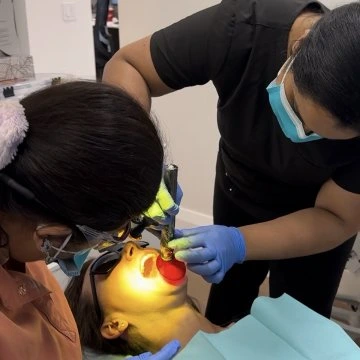 book an appointment
book an appointment
 Call 519-900-5366
Call 519-900-5366

Composite fillings represent a modern, effective method of restoring dental cavities and repairing teeth damaged by decay or minor trauma. Compared to dated metal fillings, composites are tooth-colored fillings that blend flawlessly with your natural enamel for a sophisticated, subtle result. Composite fillings are durable, mercury-free, and biocompatible, making them a safer, more appealing choice.
At Magnolia Dental Guelph, our skilled team uses advanced techniques and high-quality materials to ensure every filling provides long-lasting function and a flawless finish. If you’re looking for a dentist in Guelph offering expert tooth-colored fillings, we’re here to restore your smile with precision and care.
Aesthetic & Long-Lasting Dental Restorations
Composite fillings are restorative materials made up of a resin-based material that closely matches the color and texture of natural teeth. They bond directly to the tooth structure, making them appropriate for front and back teeth.
When compared to silver amalgam fillings, composite materials offer improved esthetics and retain more of your own tooth. They’re also free of mercury and are safe for patients with metal sensitivities. Besides filling cavities, they’re often employed in cosmetic dentistry to repair chipped, cracked, or worn-down teeth, and to close small gaps between teeth.
At Magnolia Dental Guelph, we specialize in placing composite fillings in Guelph that not only restore strength and function but also maintain the natural look of your smile.

Selection of composite dental restorations delivers an overall palette of advantages both functionally and esthetically:
At Magnolia Dental Guelph, we are experts at providing quality cavity treatment in Guelph with methods that focus on both your comfort and long-term oral health. Have faith in the top dentist in Guelph to revive your smile with accuracy and innovation in dental restoration.
Composite fillings are extremely versatile and popular in both restorative and cosmetic dentistry because they are so flexible and have a strong bond to tooth structures. They offer efficient solutions for numerous dental issues. Indications are:
Composite resin’s malleability facilitates fine, custom shaping, making it a favorite choice for delicate, conservative contouring. Whether you need a durable repair or an elegant cosmetic tweak, our Guelph dental clinic provides high-quality white fillings tailored for durability, functionality, and natural beauty in tooth restoration in Guelph.



Our staff at Magnolia Dental Guelph conducts composite fillings with a meticulous, effective, and evidence-based approach employing best practice in contemporary restorative dentistry. We get most treatments done in one visit with a proactive approach to conservation of sound tooth structure and long-term success.
Step 1: Removing decay and cleaning the tooth
We cover the affected tooth with a rubber dam or cotton rolls to isolate it. We eliminate decayed dentin and enamel with a high-speed handpiece or air abrasion system based on the extent and depth of the lesion. We conservatively design the cavity to preserve as much healthy tooth structure as possible.
Step 2: Layering the composite material
We etch the conditioned area with 37% phosphoric acid to condition dentinal tubules and enamel prisms. We next apply a dentin bonding agent and cure using a visible light unit. We insert composite resin in small increments to reduce polymerization shrinkage and maximize adaptation.
Step 3: Hardening with a curing light
We cure every increment with an LED curing light that is adjusted to the material’s specifications. This will create full polymerization and mechanical properties.
Step 4: Shaping & polishing for a natural look
We anatomically shape the restoration with carbide and diamond burs. We check and adjust occlusion so there is even contact during functional movements.
Step 5: Finish and polishing
We smooth the surface texture and luster with finishing discs and polishing points to the conformance of adjacent tooth structure, having a smooth, esthetic finish that is resistant to staining.
The procedure yields a strong, biocompatible restoration that accommodates occlusal function and natural esthetics. Guelph patients having teeth restored are treated with meticulous, patient-focused attention with the latest materials and techniques
A small fix today can save a bigger problem tomorrow.
Most individuals overlook minor signs such as a sensitivity or a small chip until pain makes the decision for them. At Magnolia Dental Guelph, we prefer to act early, treat exactly, and ensure you never feel like “just another patient.”
Book now. Stop the future. And feel what considerate dental care really feels like.
Tired of toothaches or visible metal fillings? Our natural-looking composite fillings not only restore your teeth but blend seamlessly with your smile. At Magnolia Dental Guelph, your comfort and confidence come first.

Composite fillings usually last 5–10 years, but with proper oral hygiene, they can last longer. It depends on the size and placement of the filling, your biting force, and your adherence to regular dental care.
Yes, composite fillings are completely mercury-free and are made up of biocompatible materials. They naturally bond with the tooth and don’t have any release of toxic materials, so they’re perfect for sensitivities or individuals looking for metal-free dentistry.
Composite fillings will stain if constantly exposed to substances such as coffee, red wine, or tobacco. But they’re less likely to discolor with good brushing, flossing, and regular professional cleanings.
Most dental insurance policies cover composite fillings, particularly on front teeth. Some policies will provide partial coverage for posterior fillings, so we always advise you to contact your provider prior to treatment.
Composite fillings look more natural and involve less tooth removal. Amalgam might wear longer in some of the heavy-bite locations, but composites have better aesthetics and bonding potential without metal.
Most people experience no discomfort during the process. We usually finish shallow restorations without anesthesia, and when necessary, employ mild numbing methods for your comfort.
Brush twice daily, floss once a day, and avoid chewing on hard objects. Get regular check-ups with your dentist to check on the condition of the filling and detect early wear.
If a filling comes out, contact your dentist right away. Waiting may allow your tooth to be damaged further. We can fix it easily with little pain.
Once the anesthesia has worn off usually within a few hours you can eat. Eat soft foods at first and don’t chew directly on the new filling until your bite feels normal.